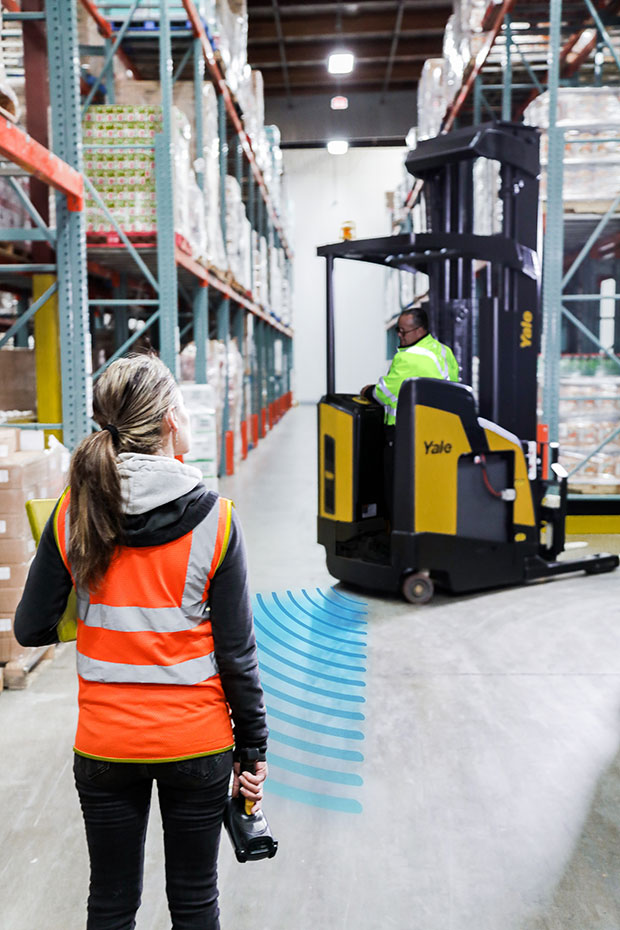Technology has the power to reshape the landscape of warehouse operations by using cutting-edge Operator Assist Systems (OAS) to enhance operator performance and mitigate the risk of accidents occurring by reinforcing best practices and increasing reaction time. Daniel Heap, Manager, Product and Commercial – Technology and Connected Fleet, Yale Lift Truck Technologies explains.
 Today’s warehouses face constant pressure to do more – fulfilling greater volumes of orders at an increasingly fast pace. Meeting these intense throughput targets depends on lift truck operators performing at their best, day in and day out. As operations work to maximise productivity at every turn, maintaining a strict focus on lift truck best practices and facility-specific traffic rules can be a challenge.
Today’s warehouses face constant pressure to do more – fulfilling greater volumes of orders at an increasingly fast pace. Meeting these intense throughput targets depends on lift truck operators performing at their best, day in and day out. As operations work to maximise productivity at every turn, maintaining a strict focus on lift truck best practices and facility-specific traffic rules can be a challenge.
In the event that errors do happen, businesses risk compromising equipment, facility infrastructure and even the safety of personnel, while accumulating financial costs and unplanned downtime they simply cannot afford. With so much riding on the performance of lift truck operators, it’s imperative to build and support safe, effective habits through proper, comprehensive training. And, just as technology has optimised other aspects of warehouse operation, it can also elevate lift truck operator training, from virtual reality simulators that can supplement mandated instructions to modernised training videos and instructional formats that can support engagement and comprehension in adult learners.
But what if you could go a step further, with technology that offers alerts and automated assistance to operators in real time on the warehouse floor?
What are operator assist systems?
While some may be familiar with systems that consider equipment status or load stability to provide a visual alert or even performance intervention in limited circumstances, a more advanced OAS delivers real value by going several steps further. A solution like Yale Reliant™ also leverages information related to the operating environment, including precise, real-time location and proximity data to enable automatic performance adjustments for a range of scenarios tailored to warehouse operations.
Some of these capabilities include preventing lifting and carrying loads beyond weight limits, automatically reducing speed for stability while cornering, restricting equipment from entering pedestrian-only zones, slowing down at the end of aisles or intersections, and limiting speed and acceleration in pedestrian-heavy areas.
The enabling technology suite
Yale Reliant continuously gathers inputs from multiple detection technologies to implement performance adjustments to travel speed, acceleration and hydraulic functions while maintaining the dynamic centre of gravity of the truck and load within the truck’s stability triangle.
Object detection utilises 2D lidar sensors to continuously monitor the path of travel (forks trailing) and actively limit truck performance in response to objects, pedestrians, equipment and infrastructure being detected. Proximity detection uses ultrawideband (UWB) technology, which provides 360° support to detect potential hazards that reside outside of an operator’s field of view, and actively limits truck performance when in close proximity to similarly equipped trucks, badge-wearing pedestrians and localised beacons.
Real-time location sensing (RTLS) is a server-based system that allows warehouses to set business rules with customised geofencing to proactively reduce travel and hydraulic speed when operators approach pre-determined areas within your facility. Additional infrastructure is required and will enable the implementation of specific use cases, such as speed control zones, exclusion zones and end-of-aisle slowdown.
The user experience
In practice, alerts and automated interventions work seamlessly. When pedestrians with proximity tags approach connected equipment, their tag vibrates, alerting them. For lift truck operators, the system monitors distances between trucks, equipment, and pedestrians with tags. Breaching the proximity threshold triggers visual and performance alerts on the truck-mounted OAS display, automatically slowing down the lift truck to provide clear notice and additional reaction time to the operator.
While the system limits performance based on real-time equipment status, location and operating conditions, the operator always remains in control of the lift truck. Feedback on the OAS display also communicates why the system intervenes. This can make OAS a helpful tool to reinforce proper lift truck operation already established during operator training.
Introducing Yale Reliant to your operation
The integration of operator assist systems such as Yale Reliant™ represents a significant advancement in warehouse operations. By enhancing operator performance and mitigating the risk of accidents through real-time alerts and automated assistance, these technologies have the potential to reinforce best practices and increase reaction time, which may ultimately result in safer and more efficient operations.
Learn more about Yale Reliant at www.yale.com




Comments are closed.